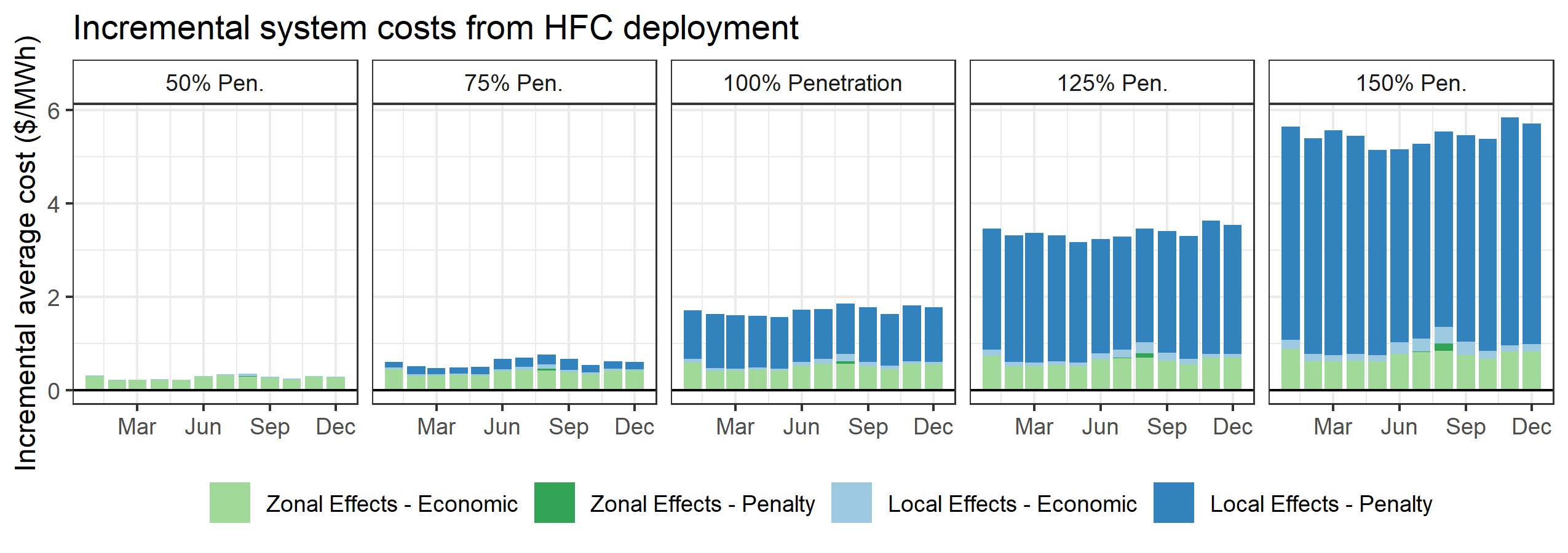CEEPR Working Paper 2021-003, February 2021
Andrew M. Mowry and Dharik S. Mallapragada

The incoming Biden administration has positioned pro-climate infrastructure spending as the key pillar to support its ambitious economic and domestic policy goals. Already it has announced its intention to electrify the 600,000+ vehicle government-owned fleet (WH 2021) as well as to build 500,000 new EV charging stations (Biden 2020). The demand pull for more EVs and the anticipated monetary support for more charging stations should do much to accelerate the electrification of the American transportation sector, which contributed 28% of U.S. greenhouse gas emissions in 2018 (EPA 2020).
While vehicle electrification in the context of a low-carbon electricity generation mix will benefit air quality and mitigate climate effects, the additional electric demand from EV charging could pose challenges to the planning and operation of the electric grid. The impacts caused by workplace and home charging on distribution networks are well studied, but those caused by highway fast-charging (HFC) have not been examined in detail. The demand from these HFC stations, which are needed to alleviate “range anxiety” concerns and to enable EV travel between urban centers, is likely to be inflexible, high-powered, and spatially-concentrated. Moreover, these stations are often located in far-flung locations with weak transmission networks. Altogether, these qualities could lead HFC to have outsized costs and congestion impacts on the power grid (Burnham et al. 2017). In this research we probe this topic: what will be the impacts of large scale HFC network on the power grid? And how might they be mitigated?
To study these questions, we model a plausible HFC network and power system of Texas in 2033, when ERCOT (the Texas power grid operator) projects that 3 million passenger EVs will be on the road (ERCOT 2018). We account for ERCOT’s estimated renewable energy and transmission buildout between now and 2033, and we use global EV charging infrastructure statistics and the present-day Tesla Supercharger network to estimate HFC locations and peak demand in 2033. To understand the impacts of HFC on the grid, we simulate the joint charger-power system operation for a full year at detailed spatial (~3500 buses and over 9000 transmission lines) and temporal (hourly) resolution for various levels of EV penetration.
A main result is shown in the attached figure, where the middle panel shows the incremental operational costs (above the case without HFC) associated with the 3 million EV base case: about $2/MWh. (For context, the marginal cost of wholesale power in the ERCOT system is usually about $20-30/MWh.) Importantly, about 50% of these incremental costs (shown in blue) are “Local Effects” caused by congestion in the transmission system around individual stations. These effects are not visible without a fully locationally resolved (“nodal”) power system model, which previous studies have not used. As EV penetration increases, these “Local Effects” begin to dominate, and thus should not be overlooked.
After identifying the system costs that HFC stations could impose on the power system, we explore mitigation methods. We first demonstrate that demand flexibility, e.g. delaying charging by one hour until power is cheaper or the system is less constrained, is not as effective as the prototypical 4-hour energy storage, like the Tesla Powerpack, at reducing these grid operational costs. (This is convenient, since it is unlikely that hurried highway travelers would want to delay their travel plans for very long.) The intuition for this result is that demand flexibility can only shift a short period of charging by about an hour, whereas a battery can shift a longer period of charging much further into the future. Taking this logic further, we qualitatively asses transmission reinforcement as a mitigation strategy: transmission can act as an “infinite duration battery” by moving energy in space rather than time. While effective, the costs and timelines for reinforcement projects are difficult to generalize beyond case studies.
By identifying the local impacts of HFC stations and moving the discussion past demand flexibility (which often is an assumed default solution to all challenges relating to power demand from EVs) we hope to stimulate the discussion of charger-grid interactions at the large scale. As automakers and governments push for electrification of the transportation sector, this analysis highlights the need for effective planning for highway EV charging infrastructure that accounts for the impacts on local power infrastructure and considers appropriate mitigation strategies.

References
Biden Campaign Website. 2020. “The Biden Plan to Build a Modern, Sustainable Infrastructure and an Equitable Clean Energy Future”. Online resource accessed January 2021. https://joebiden.com/clean-energy/
Burnham, Andrew; Eric J. Dufek; Thomas Stephens; James Francfort; Christopher Michelbacher; Richard B. Carlson; Jiucai Zhang; Ram Vijayagopal; Fernando Dias; Manish Mohanpurkar; Don Scoffield; Keith Hardy; Matthew Shirk; Rob Hovsapian; Shabbir Ahmed; Ira Bloom; Andrew N. Jansen; Matthew Keyser; Cory Kreuzer; Anthony Markel; Andrew Meintz; Ahmad Pesaran; Tanvir R. Tanim. 2017. “Enabling fast charging – Infrastructure and economic considerations”. Journal of Power Sources 367. Doi: https://doi.org/10.1016/j.jpowsour.2017.06.079
(EPA) US Environmental Protection Agency. 2020. “Inventory of U.S. Greenhouse Gas Emissions and Sinks: 1990-2018” (Annual Report). Online resource accessed January 2021. https://www.epa.gov/ghgemissions/inventory-us-greenhouse-gas-emissions-and-sinks-1990-2018
ERCOT. 2018. “2018 Long-term System Assessment for the ERCOT Region”. Electric Reliability Council of Texas. Web resource accessed December 2020: http://www.ercot.com/content/wcm/lists/144927/2018_LTSA_Report.pdf
Mowry, Andrew, and Dharik Mallapragada (2021), “Grid Impacts of Highway Electric Vehicle Charging and the Role for Mitigation via Energy Storage.” MIT CEEPR Working Paper 2021-003, February 2021.
White House. 2021. “Remarks by President Biden at Signing of Executive Order on Strengthening American Manufacturing”. Online resource accessed January 2021. https://www.whitehouse.gov/briefing-room/speeches-remarks/2021/01/25/remarks-by-president-biden-at-signing-of-executive-order-on-strengthening-american-manufacturing/
Further Reading: CEEPR WP 2021-003




